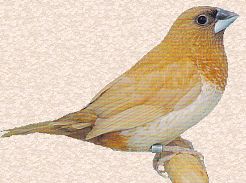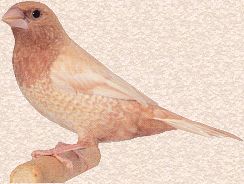
Dilute Bengalese can be found in most if not every colour of Bengalese, they are a result of a reduction in the melanins in a birds feathers and can result in some nice birds
Below is my article written for some publication in the past, what I can't recall, but now-days I have my name tattooed on my wrist for when I forget who I am.
DILUTE BENGALESE BUT MAINLY BREEDING FOR COLOUR
How did you breed those Red Grey Pastels (Dilutes)?
I was asked this question recently, and I told the fancier who asked "wait a
couple of days and I will explain my ideas on Dilutes". Well my answer
turned out to be a bit longer than expected, and only touched on Dilutes,
but for anyone who doesn't mind a bit of waffle this was my reply.
The Bengalese colouring is the product of melanin's deposited in the
feathers; these are produced from amino acids by the birds. Our birds have
the black-brown eumelanin and the red brown phaeomelanin contained in their
feathers and simply put, it is different amounts and combinations of these
that produce the different colour varieties.
Although the comments here concern mainly the Self coloured birds, out of
interest Variegation (white) is the complete absence of melanins in random
areas, causing the feathers to be transparent, but since the whole spectrum
of light passes through them, we see these areas as white.
In the not too distant past in an attempt to increase the amounts of these
melanins in the Bengalese, Continental fanciers introduced hybrids using the
Black headed and White-headed Nuns. I believe that the Black Mannikin also
played it's part, this was a very successful experiment, and has resulted in
the excellent colour we find in these birds today.
The majority of my colour breeding involves the production of "normal"
coloured birds to laid down exhibition standards for both type and colour,
our standards call for Dilute forms to display a 50% colour reduction from
this normal colouring.
In my experience it doesn't take very many generations to produce a 50%
dilution of colour in the Bengalese, this starting with birds that would be
described as "normally" coloured.
To be honest one mans Dilute is another mans Normal, it's all down to what
colour depth you consider to be a Dilute. I have birds I consider to be
Dilutes, but have seen birds of equal colour depth shown as Normals.
In Bengalese the darker colours are Dominant over the lighter, this applies
equally to different colour depths in the same colour variety, therefore all
things being equal, a normal coloured bird paired to a Dilute will result in
all normal coloured offspring. These youngsters will be "split" for the
lighter colour, and depending on your aims this is either an advantage or
disadvantage.
When we commence as Bengalese breeders it is difficult to obtain any history
of this aspect of our birds ancestry, we may be told split for this or that
but few breeders keep any records of colour depth.
As we progress and gain more experience and begin to mould our family we can
become more conversant with this aspect of our stock and begin to breed not
only for type but colour as well, with confidence of good results.
On occasions a bird will appear that doesn't follow expectation, these birds
are probably the result of factors introduced several generation before that
have "lain dormant" in our stock until the ideal combination of partners
occurs from them to emerge. This doesn't happen that often but can take us
by surprise when it does .As a general rule our pairings will most of the
time follow our predictions based on the knowledge of our own family.
My own method of assessing my birds for producing the ideal colour is
reasonably simple. Each bird is given a colour percentage, but because we
can produce birds that are too dark (I am referring to Chestnuts, Fawns and
Red Greys, Black Browns can't really be too dark) I rate the perfect bird at
75%.
As each parent contributes in theory 50% of the offspring's makeup, our
ideal pairing would be
75% x 75% resulting in 75% offspring, 37½% from each parent.
Using this method it will be seen that a 100% bird paired to a 50% bird
(Dilute) will give 75% offspring, 50% from one parent 25% from the other,
this has in the past resulted in some good coloured youngsters for me. The
down side depending on your viewpoint is that, these 75% youngsters are
"split" for 50%, or split for Dilute. Unfortunately in our quest for the
ideal 50% Dilution we produce birds that span the entire range from 10% to
70%, as this 50% Dilution is left at the end of the day to the individual
judges opinion of 50% it's not easy to breed Dilutes for the show bench.
When pairing for colour care must be taken to ensure we do not end up
producing lighter and lighter birds by careless pairings, it's easy to lose
good colour without effective and up to date records.
Care should be taken when using soft feathered buff birds, especially in any
attempt to improve type, due to these birds having defective hooklets in the
feather barbules, the distribution of the melanins is affected giving a
lighter colour to these birds.
In essence the production of Dilutes (and Normals) is down to colour
selection in the first instance, and then by selection for the percentage of
desired colour to improve and maintain your stud.

